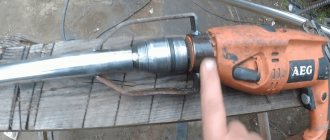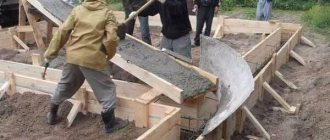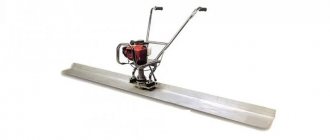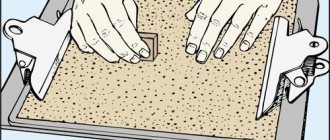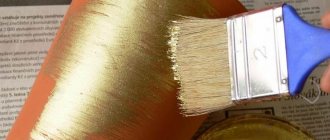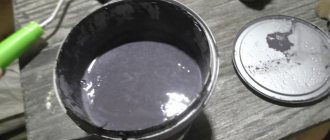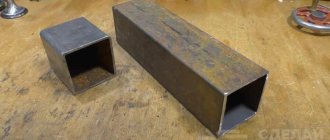The need to make a construction vibrator for concrete with your own hands may be needed in a variety of situations. A vibrator is a specialized construction equipment that is used to improve the properties of poured concrete structures. Thanks to a vibrator, air bubbles can be removed from a freshly poured solution, distributing the moisture evenly and achieving a homogeneous structure and the strength of the monolith.
Today the market offers a large selection of vibrators, but their prices are quite high. Therefore, in the case of one-time work or simply no desire to spend money on a device, you can design an internal vibrator for concrete with your own hands.
Typically, equipment is made on the basis of a rotary hammer or drill, adding certain structural components and modifying some mechanisms.
Construction of a vibrator from a drill
To make a deep vibrator at home from a drill, you will need either a ready-made factory attachment or one you made yourself. The entire technological process can be divided into several stages:
- Prepare a steel tube with a length of 500−700 mm and a diameter of 30−40 mm.
- The inner rod is made. A metal pin with a diameter of 10-15 mm is suitable. A rectangular plate 15-20 mm wide is welded to it.
- Having drilled a through transverse hole at the end of the rod, intended for fastening the drive, the pin is connected to a steel tube.
- To ensure free rotation of the core, roller bearings are needed, into the inner diameter of which the rounded end of the pin must fit tightly.
- If the end of the rod protrudes too much from the side of the bow, it is shortened slightly, leaving no more than 10 mm. A sleeve is put on the other end of the rod.
- Prepare a dense waterproofing rubber or plastic tube and kingpin. With their help, an eccentric shaft is made that connects the drill to an already made attachment.
- A tube is placed on the shaft so that approximately 3-4 cm remains on both sides. A hose is pulled onto the sleeve and compressed with a clamp, and the tip is covered with a protective casing.
A homemade device can easily replace a purchased unit, and its production does not require large expenses or the study of complex drawings.
Vibrator design, design options for main components
There are different types of concrete vibrators. According to the method of influencing the poured solution, the tool is divided into two types:
You can make both types of tools in your home workshop.
Despite the design differences, the equipment has the following common main components:
- drive – the main element of the system, which sets in motion all the other moving parts of the mechanism;
- unbalance – a unit that creates vibration;
- shaft.
Factory products are driven by pneumatic, fuel, electric and hydraulic motors. To assemble a homemade vibrator for concrete at home, it would be optimal to use an electric motor from various power tools. Suitable for these purposes:
You can also use a separate electric motor from other tools or equipment. In all cases, it is necessary that the electric motor used has the following technical indicators:
- speed from 3000 rpm;
- Possibility of connecting to a stationary power supply with a voltage of 220 V.
The power of the selected electric motor will affect the efficiency of the work: the higher it is, the more productive the created homemade product will be, and the likelihood of its overload will decrease.
The unbalance (vibration device) is a relatively difficult vibrator unit for practical implementation. For submersible-type models, this is a vibration attachment consisting of a rubber coupling, a sleeve and a metal (steel) impact part.
Making a concrete sealer at home is possible without this unit, which will only simplify the work.
Internal vibrators are equipped with a flexible shaft that transmits the drive movement to the vibrating tip. A vibrating nozzle is lowered into the thickness of the poured mixture to be compacted and distributes vibrations throughout the solution. A flexible shaft can be made from a stainless steel rod (cable), bearings, or a steel tube.
If you rarely work with concrete, then the easiest way to assemble a vibrator is to use an electric drill or hammer drill as a basis.
Vibrator based on a hammer drill
After the vibrator circuit for functioning in concrete has been prepared, you can begin installing the equipment based on the hammer drill. To construct this device, you will need some tools and materials:
- a hammer drill with a minimum power of about 2 kW;
- steel washer;
- peak.
An in-depth tool for mixing concrete mortar is installed in several stages. The most important thing is to use a hammer drill with a power of at least 2 kW. The use of the tool will be performed in a percussion system and this is worth learning during the preparation process.
It is advisable to use a lance as a nozzle for the equipment. It is necessary to construct some kind of base for the peak during operation. To accomplish this task, you can install formwork. You can create the required adhesion between these two elements by using a steel washer.
Equipment for mixing concrete mortar created independently, under conditions of a small volume of the mixture, can be made using bayonet technology. This technology requires mounting one nozzle onto an existing nozzle.
Diagram of a deep vibrator with a flexible shaft.
For this technology, it is important that the length of the entire nozzle bayonet of the equipment corresponds to the depth of the container. The nozzle will need to rest against the bottom of the container and change its position from time to time
The advantage of this technology is that it is possible to mix a large amount of concrete mixture in a short period of time.
The methods described above make it possible to create deep-depth equipment with the lowest financial costs
It is important to take into account that all the components and components used during the creation of the tool can be changed to different analogues. Replacements will be no less functional
In order for the replacement to be equivalent, it is important to study the principles of operation of the equipment.
Vibrator operating principle
Before you start making a vibrator on your own, it’s worth studying a little about the principle of its operation. The main purpose of this device is to eliminate air cavities and moisture from the concrete solution using a special movement of its nozzle, which is lowered into the cement. Due to the use of this equipment, the solution becomes more plastic and viscous, and the concrete solution is carefully placed into the desired shape without the formation of air cavities. In addition, everything is done as efficiently as possible. The use of this equipment has a positive effect on the performance of all construction processes as a whole. If you refuse to use it, the work will take much more time. The finished structure is stronger and more durable and has many other advantages.
The simplest vibrator: recommendations
The simplest is considered to be a deep vibrator, which is made from a conventional hammer drill. For this purpose, a tool is taken whose power exceeds 1.5 kW. The device must have a shock mode.
Parameters of deep concrete vibrators.
For the working attachment, a very ordinary peak is used so that you can rest on the formwork. For better adhesion, a metal washer with high strength is placed. As a result, the spreading of the concrete mixture appears more uniform.
For processing large surfaces, the “bayonet method” is used. A special additional attachment is placed on the tip of the lance. It is long enough to touch the bottom. Carefully moving the hammer drill, process the entire surface.
How to make your own submersible vibrator for concrete
To evenly distribute concrete and completely fill the formwork, builders use special devices - vibrators. Air bubbles in the mixture contribute to corrosion of the reinforcement; the moisture that accumulates in them in winter turns into ice, expands and causes cracks to appear. Therefore, the use of compaction tools is a necessity. Additional benefits: increased fluidity of the solution and reduced hardening time.
There are two types - surface and submersible. The former are used only when pouring screeds of small thickness, the latter are compacted not only on the surface, but throughout the entire depth. If the device is needed for a small amount of work, then you don’t have to buy it, but make it yourself from improvised tools.
Deep vibrator device
- Drive (220 V). When manufacturing on your own, it is used as: a single-phase electric motor with a power of 0.75-2 kW and a rotation speed of 1500-3000 rpm; a drill with a power of 1 kW or a hammer drill with a power of 1.5 kW.
- Flexible hose up to 7 m long with a shaft inside. This part supplies torque from the electric motor. To make it, they usually use a sewer cleaning spring (plumbing cable), which can be purchased at a plumbing store.
- Working tip (mace). This is an elongated cylindrical part with an eccentric inside, due to the movement of which vibration is transmitted. The mace is made from a pipe made of stainless steel. Other metals are not suitable due to low strength or susceptibility to corrosion.
General recommendations for use
If you need to mix a large volume of concrete solution, for example, to install a monolithic base, you can use a vibrator based on a hammer drill
Nevertheless, it is important initially for such purposes to create a metal frame to secure the hammer drill, and also to mount a special steel platform. To install a vibrating tool, you must remember that its length should not exceed 100 centimeters. You also need to know that all connections must be designed especially carefully, because they will be subject to heavy loads and vibrations.
In order to fill a monolithic base or process a large volume of solution, it is recommended to use flat equipment
In order to be able to perform such work, it is important to have a high-power hammer drill, as well as a steel frame on which it will be mounted. We must not forget about preparing a special platform made of stainless metal
A vibrator made by yourself, of course, cannot be used during large construction projects, but in private or personal use it is quite possible. The financial savings are absolutely obvious.
For what purposes is it used?
Deep devices are used for the construction, casting or assembly of monumental structures made of concrete (simple and reinforced). The vibrator is also designed to break up lumps of cement in poorly prepared mortar.
The electric apparatus is used for pouring floor slabs, columns and the following types of foundation:
- pile;
- slab;
- tape;
- screw;
- shallow;
- columnar.
The effectiveness of working out the solution with a vibration device is clearly demonstrated when coarse crushed stone is used in the work. In such an environment, air is stably retained, and it is only possible to expel it using a hardware method.
Purpose
The prepared concrete solution, despite thorough mixing, remains heterogeneous, which leads to a violation of technical and operational characteristics. In addition to cement laitance, crushed stone and sand, it contains water and air bubbles.
If concrete is simply poured into the formwork, the result will be a structure that is heterogeneous in structure. Air will remain in the middle, shells will form, and the fillers will not “pack” into a dense monolith.
The use of a vibration compactor for concrete increases the fluidity of the mixture without additional additives, due to the movement of its components. Air inclusions are pushed onto the surface of the monolith, and the fillers are evenly distributed throughout its volume.
During operation of the vibrator, the volume of concrete poured into the formwork is reduced by 30%. This effect occurs due to getting rid of air-filled voids and more dense packing of sand and crushed stone. As a result, the strength of a massive structure reaches the maximum possible value and high density for a given grade of concrete.
Operating principle of the device
When the foundation of a building or structure is filled with concrete (especially if it is not sufficiently moist), the composition inevitably becomes saturated with air. In dried concrete, these air layers (their volume sometimes reaches up to 50% of the total poured area) create voids that reduce the strength and stability of the entire building.
To remove air bubbles from the poured base and compact the crushed stone included in the solution, “bayonet” the concrete surface using screws or pieces of reinforcement. The pressing method for layer-by-layer filling is also used.
DIY vibration screed
Let's also consider how to assemble a vibrating screed for concrete with your own hands, used to smooth and compact the mixture. Its design is no more complicated than a vibrating mace for a drill - you will need virtually the same equipment. The materials and details are slightly different.
Materials and parts for a homemade vibrating screed
- Rolled products (angle, channel, half-T) for slats and frames. If it is possible to weld in an inert gas (argon) environment, it is advisable to choose aluminum; the design will be lighter. True, aluminum parts can be assembled using screws, bolts and nuts.
- Blanks for the manufacture of weights and bearing housings.
- Sheet steel for bearing housing caps.
- An electric motor, preferably with a shaft output on both sides of the housing. If this could not be found, then you can either lengthen the shaft on the other side, or make a vibration exciter with one unbalance. But it will be somewhat less reliable..
- Bearings with an inner race diameter equal to the diameter of the electric motor shaft.
- Pipe for making handles.
- Tinplate for making casings.
- Fasteners
- Wires and starting fittings for connecting the electric motor.
For our design, we also choose the simplest unbalance vibration exciter.
Assembly of the structure
We list the main stages of work:
- Assembling the frame. It consists of a vibration lath itself (on which the vibration exciter will be mounted) and a leveling lath, connected by several jumpers (like a ladder).
- We fix the electric motor to the rack using brackets and bolts.
Next we need to install unbalances on the motor shaft. It would be possible to directly attach them to the motor shaft, but we will install additional support bearings.
This is due to the fact that the motor bearings are mounted directly into its aluminum alloy cover. Due to the loads when the unbalance rotates, the sockets will quickly break, and the cover itself may collapse - aluminum is quite fragile.
- We manufacture (turn) housings for bearings and covers for them. For greater reliability, we also provide for the installation of cuffs (oil seals).
- We install the bearings into the housings. Before doing this, be sure to lubricate them.
- We place the bearings on the motor shaft.
- Now we mount the housings onto the frame. We do this after installing the bearings on the shaft for the reason that it is easier to determine the exact position relative to the shaft. We also use brackets for mounting.
- We install the cuffs and housing covers in place. They can be secured with screws. To ensure a tight seal, we put at least cardboard gaskets under the lids.
- We make unbalances. They are a flywheel, which, in addition to the hub, has only one sector of approximately ninety degrees. Special precision is not needed, since its main task is to rock the structure and not smooth operation. Therefore, you can cut a turned or finished flywheel with a gas cutter and sand it.
- We put imbalances in place. The fit should be very tight. Just a key is not enough; we additionally secure it with a bolt and washer screwed into the hole along the axis of the shaft. Moreover, with a thread, the direction of which does not allow the screw to come out when the shaft rotates. We also provide security against self-unscrewing in the form of an additional cotter pin or stopper.
- We make handles with which we will move the vibrating screed. They must be securely fixed, so we provide struts.
- We make casings from tin that protect the rotating shaft and weights. This is necessary for safety. It is advisable to make them easily removable.
- We install a switch on the handle to start the electric motor.
- We install the electrical wire. You can lay it inside the handle pipes.
- We are testing the mechanism.
- If everything works, we paint the structure.
By the way, instead of a self-made vibration exciter, you can use a purchased one. This will not only greatly simplify the side work, but will also make the vibrating screed more productive.
Nozzles
In some cases, drilling holes in concrete requires a product such as a diamond concrete bit for a hammer drill. In most cases, this tool and others like it are not supplied with the hammer drill.
It should be noted that their cost is quite high, and if you take into account their kit, it can cost more than the hammer drill itself. However, the presence of such attachments is extremely necessary when carrying out certain work.
Diamond bit for concrete
The most ordinary crown for drilling concrete will be inexpensive, but will also work for a short amount of time. You can increase its service life in the following way: during operation, the product should be watered with cool water to prevent it from overheating.
Therefore, for this type of work it is better to use diamond crowns. They are much more practical than simple attachments, and drilling holes in concrete with a hammer drill with their help is much faster. When choosing diamond bits, you must take into account that they are designed for different types of hammer drills, so you need to know their permissible size.
It is also worth mentioning the concrete drill. In most cases, such products that come with a rotary hammer fail very quickly due to the manufacturer’s desire to save money and equip a high-quality device with second-rate consumables. Therefore, construction experts recommend not using them, but purchasing separate sets or single products from well-known brands, but only from certified sellers. Using a cheap Chinese drill with an expensive hammer drill is extremely inappropriate.
Different sizes of concrete drills
If you need to make a hole in the wall, you need to use a chisel
It is important to remember that products made of hardened metal are not suitable for such purposes, so that it does not break prematurely. For the same reason, it is necessary to constantly sharpen it.
It is important to know! If the repairs will be done by a team of builders, then it is better to check with the foreman whether the list of consumables includes attachments for the hammer drill. Some craftsmen include them in the cost of their work, and some in the general estimate
Tips for use
When using an in-depth vibration tool, adhere to the following rules:
- Work with a solution of concrete, sand and crushed stone is not interrupted or postponed: vibration is done while the mixture is liquid. The vibrating needle is inserted strictly vertically into the concrete layer, not allowing horizontal movement, to a depth equal to the height of the top layer plus 10 cm of the previous layer of solution. The surface of the concrete the fills are divided into sectors with a circumference equal to 8 diameters of the vibrator tip. Each of them is passed through the device in turn. The vibrating needle of the device is left in the thickness of the building material for 10 seconds, then they move on to the next sector. For thick concrete, the time of exposure to vibrations is increased by 5 seconds; for fluid mortar, it is reduced by the same time. The vibration time depends on the brand of concrete and the diameter of the vibrating needle. Remove the mace from the thickness of the concrete slowly so that the solution fills all the voids. Near the surface, the device is pulled out with a quick movement to prevent vibration vibrations along the top layer. It is understood that the concrete is compacted, along a smooth shiny surface of the substance, without visible bubbles.
What you need to know before working with a homemade vibrator
For your home, it is not at all necessary to buy a factory tool, the cost of which is at least 3-4 thousand rubles. It is much more rational to make an attachment for a hammer drill or drill yourself, using improvised means. However, after production, the following factors must be taken into account:
- The device belongs to the homemade category, so there can be no talk of reliability, and from this it follows that the safety of such devices does not meet the standards
- Carry out work only and exclusively in protective clothing
- Do not overload the tool, since the considered attachments are not intended for use with a drill and screwdriver according to the instructions, so any overload can cause failure of the electric motor and other components
- Use the tool only for personal purposes, and do not use it in production, as it can cause serious consequences.
It is clear from the material that making a vibrator from a drill and a hammer drill is not at all difficult, and there are many options for this. These options will help anyone and everyone who is wondering how to make a concrete compactor attachment at home. If you compare a homemade device, the cost of which does not exceed 50 rubles (for electricity during welding work), with Chinese factory vibrators costing 3-4 thousand rubles, then do-it-yourself models work even much more efficiently.
Publications on the topic
An old hand drill - what you can do with it yourself
How to use a grinder to make a circular saw
We make knives from a file at home
Self-made attachment for an angle grinder
Operating principle of the device
Before you start making a vibrator for concrete, you need to understand how this device is designed and what functions it performs. Walking past a construction site, many have probably noticed how workers mix the concrete mixture using a special tool.
The standard scheme of such a device includes:
- engine (electric, gasoline or pneumatic);
- transmission mechanism;
- eccentric (vibration generator).
Through a flexible transmission, the motor starts the rotation of the vibrating mace, which transmits the required vibration frequency to the working surface in contact with the solution. A vibrating mace, immersed directly into the thickness of unhardened concrete, creating high-frequency vibrations, allows you to effectively influence problem areas and control the quality of processing of concrete mortar. Without performing this procedure, a lot of oxygen remains in the solution, which is why the future monolithic structure is not strong enough.
It is not difficult to guess that the main function of the deep vibration unit is the destruction of air bubbles formed in the cement solution during the mixing process . In addition, the vibration device promotes the release of excess moisture. As already noted, this becomes possible due to the vibrating movements of the tool’s immersion nozzle.
After using the vibrator device, the consistency of the solution improves significantly. The concrete mass becomes more fluid, which allows it to easily fill any niche.
The coating is characterized by high reliability and long service life. Using simple improvised means, it is not so difficult to make a vibrator device for concrete with your own hands.
How to quickly and easily make a deep-well vibrator for a hammer drill
Making a vibrator for a hammer drill for compacting a concrete mixture with your own hands is not difficult if you approach this issue correctly. A homemade design is no worse than a factory tool. To make the design highly effective, you will need to prepare the consumables from which the nozzle will be constructed.
Why is a hammer drill used as a driven tool? This is an ideal tool for making a vibrator as it has a powerful electric motor with high torque. The shock mode of operation contributes to the creation of high-frequency vibrations. This vibration does useful work by compacting the concrete. So, there are no restrictions when making a vibrator for a hammer drill. You can use a variety of consumables that are available on the farm. To make a device with your own hands, you will need to know the following:
- The hammer drill has a shock function, which actually creates the vibrating action of the nozzle
- Flexibility of the nozzle is an optional feature. The flexible design acts as an extension cable that facilitates the transmission of high-frequency back-and-forth motion from the source to the receiver. It is rational to make a flexible extension only in one case, when it is necessary to vibrate deep concrete
- To connect the hammer drill to the nozzle, you will need an SDS type shank of appropriate design. A life hack for making a vibrator for a rotary hammer is to buy a separate attachment, that is, a tip with a flexible extension, to the other side of which the shank from the drill is welded. The result is a ready-made vibrator for a rotary hammer
This is interesting!
To ensure efficient operation of the vibrator, it is necessary to use hammer drills with a power of at least 1 kW.
https://youtube.com/watch?v=DmzNT-7ETg4%3F
To make a homemade device with your own hands, you will need to perform the following steps:
- Take two tubes - one of small diameter and the second of large diameter
- A small diameter tube is placed inside a larger tube. First, two bearings are welded to the edges of the tube, the outer diameter of which is 1-2 mm less than the internal diameter of the large tube. The inner races of the bearings must be welded to the two edges of the small tube
- Weld two plates onto a small tube, which will act as an eccentric - to shift the axis or imbalance
- Attach a flexible cable to the inner tube, thereby ensuring its movement inside the large pipe
- To connect a large pipe with a hammer drill or drill, you need to take a piece of rubber pipe, which is attached on one side to the tool and secured with a clamp. The second part is attached to the steel pipe, and is also fixed with a clamp
- Next, all that remains is to clamp the end of the steel cable in the drill chuck, and if a hammer drill is used as a power tool, then weld the drill shank to the flexible connector
There is another option for manufacturing a simple device. To do this, you will need a steel plate measuring 8x8 cm and 3-4 mm thick. The shank from the faulty drill should be welded to one side of the surface of the plate, and the result is a device of the following type, as shown in the photo below.
The principle of operation is that the surface of the nozzle acts on the outer part of the manufactured formwork. The impact on the formwork walls leads to leveling of the poured concrete mixture. This is the simplest and fastest option for making a vibrator attachment for a rotary hammer with your own hands.
https://youtube.com/watch?v=zk4UJEYCbYE%3F
If the floor is poured with concrete, then to level and remove air from the inner surface, you can use a hammer drill with a drill fixed in a cartridge, as well as a shovel. By acting on the surface of the shovel on one side with a hammer drill in impact mode, the concrete base will be leveled and compacted.
Not only from a hammer drill, but also from a regular drill you can also make a vibrator. Moreover, the design of the vibrator will be different. Many craftsmen even recommend using a drill rather than a hammer drill as a drive mechanism, but it all depends on the consumables available.
https://youtube.com/watch?v=IH6ncEz3P6M%3F
Design and characteristics
Based on the principle of impact on building materials, vibrators are distinguished:
- Deep. They are used to compact the foundation of a building made from a mixture of concrete, crushed stone and sand poured into a wooden frame. External. They combine the characteristics of a press and a vibrator when compacting the formwork of reinforced concrete vertical structures. Surface. Vibropresses level the surface of indoor floors and act as a compact press for squeezing out air bubbles on the surface.
A mechanical deep vibrator is an electrical device consisting of:
drive (electric motor, gasoline engine); flexible shaft with an eccentric (steel cable enclosed in a plastic sheath); vibrating tip (vibrating needle, mace).
Depending on the purpose of the work, the tips are made in the form of a bayonet, shovel or rod. By design, there are clubs with internal and external rolling.
Among the models of deep-depth devices, high-frequency ones are distinguished separately. The drive in such devices is located directly in the vibrating needle, which allows achieving the best results when compacting concrete.
Devices by area of application are:
- Home and semi-professional (with a capacity of up to 2 kW, weighing less than 20-25 kg). Professional (with a power of up to 4 kW, weight reaches 1 c).
The main characteristics for a productive concrete vibrator are as follows:
the length of the flexible shaft (the depth of the foundation that can be worked depends on this indicator); vibration frequency (direct impact on the speed of work); the shape of the vibrating head; the diameter of the concrete solution compaction.
Operating principle and design
The vibrator increases the density of the concrete solution, which leads to an increase in the strength of the entire structure. The operating principle of the instrument is to create high-frequency vibrations that disrupt the bonds between the particles of the solution, thereby changing its parameters. This allows you to achieve the following effects:
- Excess moisture and air are removed from the solution.
- The strength of concrete increases due to the elimination of voids.
- The fluidity and homogeneity of the mixture increases.
- Ensures uniform filling of the form.
- The concrete hardening process is accelerated.
- The strength and durability of the structure increases.
The design of the tool is extremely simple, and a homemade vibrator can be made in a short time, spending a minimum of money. The design consists of a shaft with a motor, a vibrating tip and a special vibration mechanism.
Deep vibrator: description, scope of application, device
Before making a concrete vibrator yourself, you need to understand the design features, purpose, and rules for using the tool.
Device Description
A vibrator is needed to work through the concrete solution after pouring in order to remove air bubbles from the thickness of the monolith, which negatively affect the strength and durability of the finished structure. During the pouring process, it is very difficult to avoid the appearance of air cavities in the thickness, but before the concrete hardens, it is imperative to get rid of them. And you can do this with a self-made device.
Thanks to high-frequency vibrations, excess air is released from the mixture, the concrete becomes more uniform, filling the form or formwork completely, without voids. Even low-quality concrete acquires positive characteristics of fluidity and density during vibration.
By design, vibrators are:
- External brick presses
– installed vertically on the formwork of reinforced concrete structures.
- Vibration presses
– used to create interior ceilings and floors.
- Deep
– used in private construction by immersion into the thickness of newly poured concrete.
Usually craftsmen make a submersible vibrator for concrete with their own hands, since making presses is impractical.
Scope of application of the deep vibrator
The tool is used in a variety of areas of repair and construction work - in the process of erection, casting of various concrete and reinforced concrete structures. It is relevant when pouring columnar, strip, screw, pile, slab, shallow foundation types, when constructing floors, monolithic columns, etc.
Device design
Any concrete vibrator (made with your own hands or purchased) consists of three main parts: a drive (thanks to which the vibration device works), a flexible shaft with a rubber gasket and a tip that acts as a vibrating mace.
The principle of operation of the device is simple: the vibrating attachment provokes vibrations in the concrete, the mass spreads evenly over the formwork or mold, air bubbles and voids with water come out, which significantly increases the strength and other characteristics of concrete.
Main characteristics of the vibrator:
- The motor power must be at least 1 kW.
- The depth of the shaft is 1-7 meters.
- All protective rubber elements must be present.
- The vibrating part of the tool can be narrowed downward or cylindrical, which depends on the thickness of the solution.
- The number of nozzles may vary.
- The shaft must be protected with a waterproof film made of a special polymer material.
- Number of revolutions per minute – 10000-20000.
DIY vibrator from a hammer drill
It is much easier to make such a device from a hammer drill. And for this you will only need: the tool itself, a piece of iron rod and a thick round plate.
The power of the tool must be at least 1.5 kW. Then it will not overheat during operation for a long time. The length of the bending rod should be such that it rests against the bottom of the formwork, where the concrete solution is poured.
- We process one side of the nozzle for the tail part, which can be clamped into the hammer drill chuck. And to the second we weld a metal plate about 50–70 mm in diameter.
- Such a pike device will ensure the combined effect of vibration of the working part of the tool with an impact moment on the formwork itself, without its destruction. In the process of vibration of the formwork walls, the efficiency of removing air masses from the cement mortar increases significantly. Such work is carried out using the “bayonet with rebound” method over the entire surface of the structure element being compacted. Each formwork point can be processed within 3 minutes. A deep vibrator made from a perforator is excellent for construction work in impact mode if it affects the formwork elements from the outside.
Preparation for production
Since ancient times, a method called “bayoneting” has been used to compact concrete; this method is the simplest, but at the same time effective. Punching the concrete mixture with any object, a metal rod, the handle of a shovel, etc., allows you to eliminate air from the solution, which is extremely undesirable in the construction mixture. Naturally, doing this by hand is very difficult.
A homemade device that can be used as a vibrator can greatly facilitate the task and can be made from an ordinary construction hammer. Most construction workers familiar with manual work have just such a tool at home, assembled on the basis of a hammer drill. To create it we will need:
- the hammer drill itself;
- a piece of metal rod, fittings;
- a thick metal plate with a large area;
The power of the hammer drill itself must be at least 1.5 kW. Only then will you be able to work for a long time without overheating. A piece of metal rod or rod (reinforcement) must reach the bottom of the poured cement block, in other words, be equal to the depth of the poured mortar. The first side of the reinforcement is machined so that it can be inserted into the hammer drill chuck and snap into place. The second end of the rod is welded to a metal plate of sufficient thickness and diameter (50 - 70 mm).
Operating principle of a deep concrete vibrator
Internal concrete vibrators are used on all construction sites. They rid the solution of excess air and moisture. The device creates high-frequency vibrations, under the influence of which the mixture becomes homogeneous and its porosity decreases. When pouring, the mold is completely filled, there are no air voids.
The unit consists of a motor with a shaft and a vibrating tip. It can be purchased at a hardware store, but it is easy to make yourself. You will need a high-quality tool on the basis of which the unit is created.
The operating principle of the device is based on the rotation of the working surface at high speed under the action of a power tool; rotational movements are converted into vibrations. Vibration causes the mortar to move, causing air to rise and be removed from the solution.
Making a vibrator with your own hands
In order to make this tool yourself, you will need the following materials:
- Power tool (hammer or impact drill).
- A steel pipe with a diameter of 5 centimeters or more and a length of 0.5 meters.
- A steel rod with a length exceeding the parameters of the pipe, while having a diameter of 2 centimeters.
- A segment of a rod of arbitrary shape in the form of a rectangle.
- A pair of bearings that are conveniently located and attached to the inside of the rod.
- A strong bushing that could create a seal.
- Cable for sewer cleaning.
- Insulation that performs the function of protecting the outer shell.
- Clamps that will compress the pipe.
The working element in the design will be a rod, one end of which must be given a hexagonal shape if a drill is used in the future. If you choose a hammer drill, it is worth welding the shank to this part, and the seam must be strong and airtight. Then a rectangular rod is welded to the second side.
The created device is placed inside the bearings using a hammer, then a steel pipe is placed on top. You need to use clamps to tighten the ends of the homemade nozzle. For reliability, attach the bushing to the rod, having previously drilled a hole of a suitable diameter in it - for the cable. Using nuts and engraving bolts, pull the cable through the hole and put a regular hose on top.
It is important to know: when performing welding work, monitor the quality of the seams, since concrete gives a large load during the work process.
The device and how the device works
When constructing a concrete structure, it is important to follow the technology, otherwise the constructed structure will not be strong and will not last long. However, such a structure is built to ensure high strength of the structure, as well as a long service life. To achieve this strength, air bubbles must be removed while pouring the liquid concrete mixture, as well as the concrete must be compacted. Previously, long sticks were used for this, which were inserted deep into the solution and manually vibrated, creating oscillatory movements.
The method of removing air from a concrete mixture using a long stick has not been relevant for a long time, since special devices were made for this - vibrators. It is an instrument created by high frequency oscillatory movements. They help break the connection between small concrete particles, compacting them. A concrete removal vibrator has a number of advantages, as it allows you to simultaneously perform the following actions:
- Removing moisture and air from the mixture, thereby increasing the strength properties of the structure
- Uniform filling of formwork mixture
- Accelerates the hardening process of the concrete mixture
- Elimination of voids that negatively affect the strength properties of the final structure
- Increases the service life of the building
- Obtaining a homogeneous concrete mass, which makes the structure uniformly strong
- Eliminates the need to pour concrete in layers
Structurally, the vibrator is an attachment that is connected to a power tool. The direct attachment is called a vibrating tip, which is connected to the electric motor using a special flexible hose. The nozzle has a simple design, and buying a specialized tool is expensive. To avoid having to use a long stick, it is recommended to make a vibrator with your own hands and connect it to a hammer drill or drill.
Step-by-step instructions for assembling the structure
It is necessary to use stainless steel as a nozzle; concrete is an aggressive environment and ordinary iron will fail very quickly. If you take crushed stone and sand into account, the strength factor will become even more relevant. It is best to take a steel tube about 4 cm thick, into the middle of which a rod 1.5-2 cm thick is pressed. An additional rectangular one is welded to the main rod. This is the only way to achieve the most effective vibration by shifting the center of gravity.
Thanks to the bearings, the rod is secured inside the tube. But at the same time, its rotation should not hinder anything. Afterwards, you need to drill a hole in one of the ends, which is attached to the hammer drill. We connect the drive to the nozzle using a bushing. The second end of the drive is fixed in the drill/hammer holder. The device with the engine turned on can be fixed with a vice near the solution being processed or held in the hands. The core attached to the hammer drill must rotate easily, otherwise there will be excessive load on the device. To do this, the metal rod is equipped with bearings on both sides. They are stuffed onto the rod (see photo).
The end that is too long in the working part of the rod, protruding above the bearing, needs to be cut off, leaving a piece of approximately 5-10 mm. The bearings themselves need to be protected from dirt and dust, and this should be done on both sides
Otherwise, the entire mechanism will stop rotating and quickly fail. Important! Don't try to save money on bearings. The durability of the structure will depend on their quality.
For safety reasons, the second end of the rod must be equipped with a protective sleeve that will completely cover the rotating part.
The hammer drill and the working tip can be connected using a special tube, which can take any shape and at the same time transmit rotational force.
The tube must be connected so that the overlap on both sides is about 4-5 cm. This is the only way to correctly transfer vibration to the working part of the system. This design compensates for the interaction of rotational and impact forces to prevent the destruction of the hammer drill chuck.
For a more detailed analysis, we recommend watching this detailed video instruction in two parts:
Concrete compacts well. Treatment of each area of the solution can take up to 3 minutes. It is also possible to process concrete formwork by acting on it from the outside.
The undoubted advantage of this technology is its mobility; the device is easy to take with you to any site. Cheapness in production is also important, thanks to which everyone can make a device with their own hands without significant financial costs.
Advantages and disadvantages of devices
The devices used for domestic and industrial purposes have the following advantages over other methods of concrete compaction:
- Ensure a reliable fit of the reinforcement to the mortar in the area of the seams.
- They use a minimal amount of electricity, but are still productive.
- They produce oscillatory movements up to 20 thousand revolutions in 1 minute.
- There are small portable models that are easy to move from place to place.
- They have a low price.
- They automate the process, eliminating the need for manual labor.
- They speed up the construction process.
- Creates a low noise level compared to other power tools of similar power.
- Convenient to operate and maintain, components are easy to replace.
The only weak point of the device is the need to use a compressor and regular maintenance.
Let's summarize all of the above
To pour a monolithic foundation or process a large area, it is best to use a flat homemade vibrator. To carry out such work, you must have a powerful hammer drill and a steel frame where it will be mounted. A site must be prepared, the material of which will be stainless steel.
Such a vibrator is quite easy to make in your own garage, using ordinary improvised means. Of course, it is unlikely that it will be possible to perform professional work on it, but for building your own home such a device will be quite sufficient. The money savings are obvious.
When the length of the vibrator exceeds one meter, work must be performed with an assistant. The connecting points must be securely fastened. Concrete is a very dense and durable material; it will exert powerful pressure on the vibrator and will try with all its might to dampen vibration. Therefore, the design of the vibrator must be durable and of high quality.
Where is the vibrating tip used?
To begin with, it should be noted that vibrators come in two types - submersible or deep and surface. Submersible ones are used exclusively when pouring concrete walls, pillars and other similar structures. Surface devices are designed to compact liquid concrete poured horizontally, that is, onto the floor or ceiling.
Before you make a vibrator for concrete using a hammer drill or a drill as a driving tool, you need to understand the use of this simple and useful tool. First of all, the nozzle is used in the construction industry when concrete structures are poured. This specialized tool is also used in the following cases:
- When to make monolithic concrete structures
- When pouring borders, pools, walls and ceilings
- In the manufacture of structures using reinforcement and liquid concrete
- When pouring the foundation
The devices in question have found their application not only in industrial, but also in home construction. Vibrators are used to build foundations, formwork, as well as pour posts and other similar structures. If in industry it is rational to use specialized tools, then for household purposes it is not at all necessary to buy such devices. If you have a hammer drill or a drill, then you can make an appropriate attachment for it, using available tools for this.
